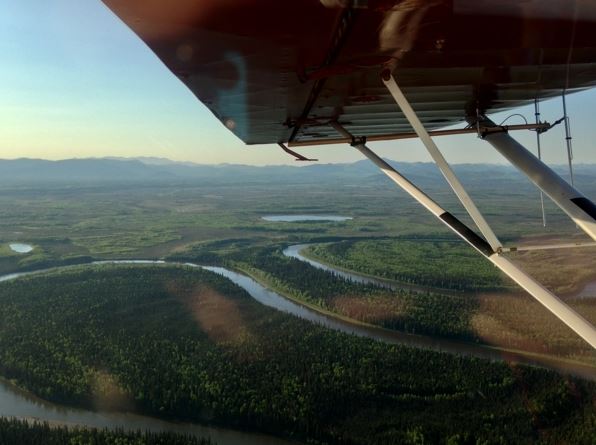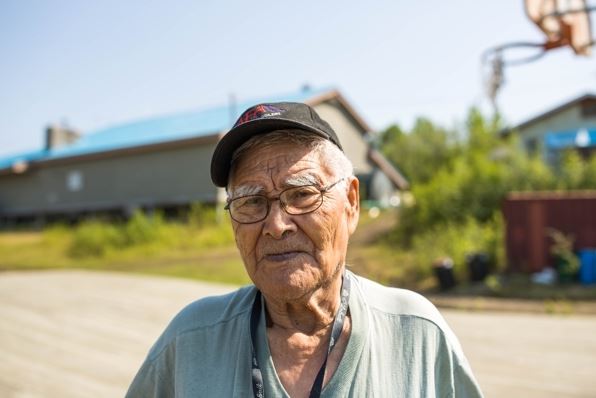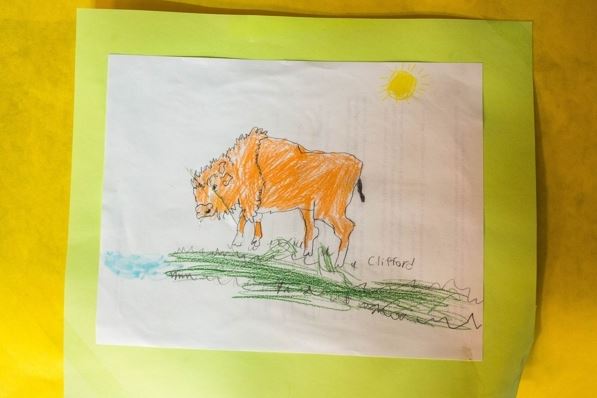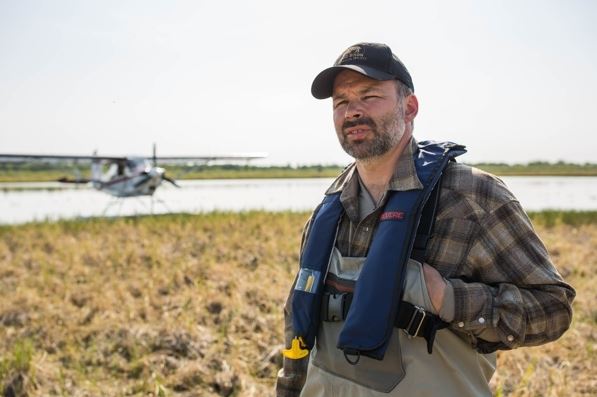Meet America’s only wild wood bison herd, which now roams Western Alaska
SHAGELUK – Wood bison calves are easy to spot from the sky. Their coats are reddish, making them easily distinguishable from their mothers, even as they appear as minuscule dots against Alaska’s vast landscape.
The calves may look insignificant from the air but they are special. They are the first wood bison both bred and born in the wilds of Alaska in more than a century — a huge milestone for what has been a lengthy and uncertain experiment in reintroducing the species to the state.
“It’s really the beginning of wild wood bison in the United States,” said Tom Seaton, the Alaska Department of Fish and Game wildlife biologist who has overseen the project for the last five years.
Their existence represents the conservation of a species once thought extinct, then revived from nearly nothing.
In late May, Seaton flew a Bellanca Scout floatplane to Shageluk to track the bison. He spotted 12 calves during the middle of their three-month calving season and expected to see a few more in a month’s time.

Seaton first tracked a solitary 9-year-old male. As bulls age, they spend more time alone, Seaton said, often joining up with other bison only during mating season. This particular bull had been hanging out on a small river island for about six months. It had likely found good habitat, Seaton said, and so had no need to travel farther.
Bulls are massive. North America’s largest native land mammals are as tall as moose and weigh around a ton. This animal’s distinctive humped back was visible from the sky as it stood shaded beneath a tree during a warm summer day.
Next, Seaton tracked a cow, not far from where a herd of about 30 animals roamed. The cow had likely moved away from the herd to give birth, Seaton said. Within the larger herd, he spotted two more calves. As he circled overhead, the babies crowded close to their mothers, shielded from the noisy distraction above.
The 400-air-mile journey from Fairbanks to Shageluk takes more than five hours, including a refuel in McGrath. Seaton has taken the trip countless times, passing over boreal forests, alpine landscapes and vast, marshy plains that have become familiar sights.
Moose, bears and caribou dot the landscape, and human settlements are few and far between.

In Shageluk, residents know when Seaton arrives. They can hear the distinct sound of an airplane passing overhead, too far from the airport, which is 3 miles from the main town, to be a commercial flight.
Shageluk is a Athabascan village of about 80 people, tucked alongside the Innoko River in Western Alaska. Surrounded by vast flatlands and softly rolling hills, the residents here are generally supportive of the bison’s presence. That support is part of the reason this community was chosen as the site for the initial release into the wild.
“The tribe and our corporation was looking at it as economic development,” said Kelly Workman, the town’s tribal administrator.
Some development has already started. Locals were employed to help construct the corral that led the bison to freedom last year.
At Leona Wolfersheim’s bed and breakfast, the project “just really opened up the business” as researchers and media travel to the community, she said.
The village corporation, Zho-Tse, has set up a foundation in hopes of providing research scholarships for the study of the bison and wildlife management.
Residents are most excited, though, for the eventual opportunity to hunt the animals.

Once there are 250 bison, their herd will be large enough to begin hunting, probably in eight to 10 years, Seaton said. He estimated that a large bull weighing one ton would produce roughly 900 pounds of meat.
Through a negotiated agreement, one of every five permits will go to local villages in the surrounding area. The rest will go into a lottery available to other Alaskans and Outsiders. Some hope local villages are further prioritized.
Longtime Shageluk resident Arnold Hamilton, who sat on the Fish and Game advisory committee that developed the management plan, hopes that hunting the bison will take some of the pressures off the moose population. He also hopes that the young people will learn about wildlife management.
“It’s going to be theirs, the future generation,” Hamilton said.

Occupying space
A total of 130 bison were released near the village in the spring and summer of 2015. The cows and calves were released first, after being flown to Shageluk and held in corrals for 10 days. In a video posted by Fish and Game, the bison are seen galloping to freedom, led by Seaton on a snowmachine.
“It was great. We had the whole village when we brought them out … we had all of the kids from the area,” Hamilton said of the event.
The bison were released near the airport and have since lingered nearby; a few were even spotted darting across the runway last week.
“When we know they’re walking around town, we announce it on the radio,” Workman said.
Once, Hamilton had to blockade the bridge leading from the airport road before a herd of the bison made its way into the main town, he said.
The bulls were released a few months after the cows, in two waves. Brought in by a barge, they were let go about a mile from a female herd.

Within 12 hours, the bulls – the products of several generations of captive animals, who had not seen female bison since they were immature – had navigated their new landscape and joined the herd, according to Seaton.
The release went better than expected.
“The main goal was to do it without injury or death to the animal, and nobody thought that was possible … the amazing thing is we actually did it,” Seaton said.
“When the 130th one walked off (the barge), I was like, ‘no way,'” he noted later.
Most bison have stayed within 30 miles of their release point but some have ventured as far north as Galena and as far south as Bethel. Seaton believes they will fill in this 300-mile span as the herd grows.
The habitat is ideal for them, lush with their food source of wild grass and sedge.
Leading up to their release, there was some concern that the bison would compete with moose for food, Hamilton said. So far, that doesn’t appear to be happening, according to Seaton.

Whether the creatures had ever lived around Shageluk before is debated by Joyanne Hamilton, who teaches at the local school. Her students found some research that wood bison had never actually been in Shageluk.
“It wasn’t really a reintroduction, it was more of an introduction” to the region, Hamilton says.
Seaton disagrees, citing wood bison bones found scattered throughout the area and oral histories gathered in Shageluk last spring as evidence of their existence.
An accidental discovery breeds a new future
In many ways, the bison’s success has been unlikely. The world’s current wood bison population – about 11,000 animals total, according to the Canadian Wildlife Service – all came from 11 animals, Seaton says, discovered by accident after they were thought to be extinct.
Nobody is quite sure why bison disappeared from Alaska. They were Interior Alaska’s most abundant species for 500,000 years, according to University of Alaska Fairbanks paleontologist Dale Guthrie, but by the time written history came around, they had vanished from the landscape. Oral histories and bison bones were all that remained.

Scientists believe that the bison’s habitat shrank and the herds became more isolated. Dwindling pockets of bison were further reduced by human predation.
“A lot of that’s theory but it’s based on the best science of our time,” Seaton said.
In the 1920s, Wood Buffalo National Park in Canada was established to preserve the last few thousand remaining wood bison in the world. Over the next several decades, though, plains bison were brought into the park, breeding with the wood bison and introducing cattle disease into the herd.
By the 1950s, wild, pure-bred wood bison were believed to be extinct, until a team of wildlife biologists stumbled upon a herd in the northwest corner of Canada’s Buffalo National Park. They captured about 25 animals, tested them and killed the ones that carried disease.
Only 11 disease-free wood bison remained, which at that point were living in Elk Island National Park, outside Edmonton, Alberta. All of the wild, disease-free wood bison in the world have been bred from those few animals, according to Seaton.
‘The amount of effort and foresight and care to do that — we owe the Canadians a huge debt,” Seaton said.
Alaska’s story
The idea for Alaska’s wood bison herd was first dreamed up 23 years ago by wildlife biologist Bob Stephenson. While working in Northeast Alaska, he stumbled upon Native oral histories of the bison. The realization of this idea, with its extensive planning and public process, took decades.
Alaska’s wood bison also originated from Canada’s Elk Island National Park. Some were confiscated in 2003 from a rancher who had illegally kept them; most were brought in by Fish and Game five years later for the project. They were held at the Alaska Wildlife Conservation Center until their release.
Their release has not been without opposition. Native corporation Doyon, Limited, opposed the project on the grounds that the species, considered threatened under the Endangered Species Act, could spur lawsuits protesting oil and gas development. The corporation, which owns extensive land rights in the Interior, sent a letter to the governor and Fish and Game calling the bison “a major and unnecessary risk.”
“When I started the project it was unknown whether we would get over the hurdle of the Endangered Species Act,” Seaton said.

Fish and Game worked for five years to get the herd classified as an experimental population. In 2014, the exception was granted, removing a third party’s ability to sue under the federal law should the bison be threatened by resource development.
Gov. Sean Parnell approved of the wood bison’s release in August 2014. Seaton couldn’t believe it at first. Then it dawned on him: He had six months to figure out how to transport 130 of North America’s largest native land mammals hundreds of miles off the road system.
Logistics were daunting. Money was also an issue. Fish and Game was only given enough money to transport 30 bison, so while planning their release, Seaton also began fundraising — or, in his words, “begging for money.”
Alaskans responded. Private donations were matched with a federal grant. Transportation companies offered huge discounts for the bison’s travel. A steel fabrication company custom-built all the transportation containers for free.
Through community support, the costs of all 130 bison were covered.
“People felt it was the right thing to do,” Seaton said.
In June 2015, when the last bison walked unharmed into Alaska’s wilderness, Seaton said the first thing he did was lean on a hay bale – where he promptly fell asleep.

For now, the bison appear to be thriving but their survival is not a guarantee. Fish and Game will continue to routinely monitor their numbers for a few more years.
Should they continue to multiply, the species’ conservation will continue to strengthen and wood bison hunts will return to Alaska.
Related Links:
Canada: Bison herd in Canada’s N.W.T. half the size of last year’s, CBC News
United States: Huge wood bison may finally range freely in Alaska again, Alaska Dispatch


